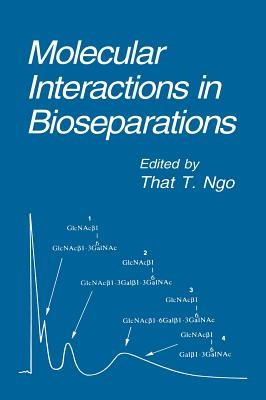
- We will send in 10–14 business days.
- Publisher: Springer
- ISBN-10: 0306444356
- ISBN-13: 9780306444357
- Format: 17.8 x 25.4 x 3.2 cm, hardcover
- Language: English
- SAVE -10% with code: EXTRA
Molecular Interactions in Bioseparations (e-book) (used book) | bookbook.eu
Reviews
Description
Rapid advances in molecular biology have accelerated the production of a great number of protein-based therapeutic agents. The major cost in producing these proteins appears to be associated with their purification from the complex mixture of the crude extract. A major challenge to the protein biochemist and the biochemical engineer is the development of rapid, efficient, and cost-effective purification systems. This volume presents state-of-the-art reviews of current methods used in the purifica- tion of biological macromolecules that are based on molecular interactions. Thus, the major emphasis is placed on affinity-related techniques. Part I provides a general introduction to affinity chromatography and includes a chapter describing an interesting new technique called slalom chromatography for DNA fractionations. Affinity chromatography using molecules of biological origin as the affinity ligand is covered in Part II. Part III describes the use of a special class of biomolecules, antibodies, as affinity ligands. Affinity chromatography with biomimetic ligands is discussed in Part IV. Newer concepts and their applications in bioseparation are presented in Part V. Part VI covers affinity-related techniques such as affinity-based extracorporeal shunts, affinity electrophoresis, affinity precipitation, and affinity extraction. I would like to express my sincere thanks to all the authors, who are recognized experts in their respective fields, for their cooperation and contributions. I thank the editorial staff of Plenum Press for their professionalism, and Mary Phillips Born, Senior Editor, for her encouragement. The support of my family (Ping and Peilin) made it possible to complete editing this book. That T.
EXTRA 10 % discount with code: EXTRA
The promotion ends in 16d.20:03:03
The discount code is valid when purchasing from 10 €. Discounts do not stack.
- Publisher: Springer
- ISBN-10: 0306444356
- ISBN-13: 9780306444357
- Format: 17.8 x 25.4 x 3.2 cm, hardcover
- Language: English English
Rapid advances in molecular biology have accelerated the production of a great number of protein-based therapeutic agents. The major cost in producing these proteins appears to be associated with their purification from the complex mixture of the crude extract. A major challenge to the protein biochemist and the biochemical engineer is the development of rapid, efficient, and cost-effective purification systems. This volume presents state-of-the-art reviews of current methods used in the purifica- tion of biological macromolecules that are based on molecular interactions. Thus, the major emphasis is placed on affinity-related techniques. Part I provides a general introduction to affinity chromatography and includes a chapter describing an interesting new technique called slalom chromatography for DNA fractionations. Affinity chromatography using molecules of biological origin as the affinity ligand is covered in Part II. Part III describes the use of a special class of biomolecules, antibodies, as affinity ligands. Affinity chromatography with biomimetic ligands is discussed in Part IV. Newer concepts and their applications in bioseparation are presented in Part V. Part VI covers affinity-related techniques such as affinity-based extracorporeal shunts, affinity electrophoresis, affinity precipitation, and affinity extraction. I would like to express my sincere thanks to all the authors, who are recognized experts in their respective fields, for their cooperation and contributions. I thank the editorial staff of Plenum Press for their professionalism, and Mary Phillips Born, Senior Editor, for her encouragement. The support of my family (Ping and Peilin) made it possible to complete editing this book. That T.


Reviews